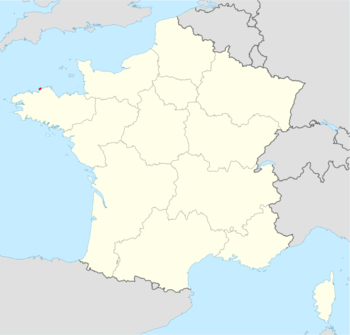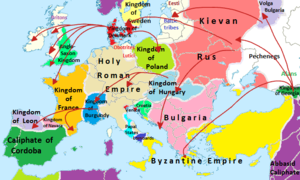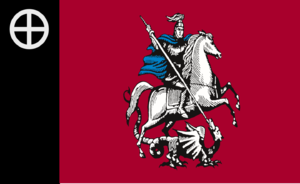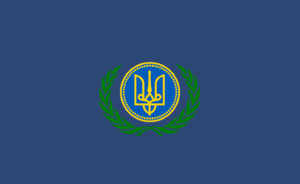Lutherian-Brittany
Lutherian-Brittany Liuteri-Bretonge | |
|---|---|
| Motto: Bretonge vistaer” Mannex: Brittany lives”' | |
| Anthem: The Iber March File:Iber March - Anthem ofbretongenew.mp3 | |
 | |
| Status | Active |
| Capital and largest city | ? |
| Official languages | French, Alanconian , Breton, Vislandic |
| Other languages | French, Alanconian , Breton, Vislandic |
| Ethnic groups | Celtic, Germanic, Italic, Iberi |
| Religion | Old Church Slavonic Orthodox Christianity, Norse Paganism, |
| Demonym(s) | Lutherian |
| Government | Democratic Republic of a Constitutional Monarchy |
| Érin Kennedy Hughes ( Anazana Nahapet ) | |
| ? | |
| Legislature | Haykaz |
| Katvi | |
| Etkatvi | |
| Independence from France | |
• Declaration of Independence | 12 April 2018 |
| Population | |
• Estimate | Unknown, census not issued |
| Currency | Iberian Mark ( MK ) |
| Time zone | UTC+1 (GMT) |
| Date format | dd/mm/yyyy |
| Calling code | +33(de facto) |
| |
Commonwealth of High Wales, Iber Rus , Alancion, Lutherian-Brittany , and The Isles are four unified nations under one ruler and name, The Red Order.
History
After being pushed out of the Caucasus by the Abbasid and Seljuks, the Iber people ( called Baturi at the time ) would go on to travel to Europe. Several different tribes ventured to different places.
 |
|---|
Prehistoric Period
- 2.5 Million Years ago ( 3300 - 1200 BC )
The prehistoric period took place in southern modern day Mongolia, as religion developed a man by the name of Asus Batyrji predicted that the promised land was in the west. When they traveled west they settled in modern day Armenia and Georgia, where the rich soil accommodated the agricultural society. In 2492 BC, The man that was believed to have been sent from “ Vaiha “ meaning God, called Hayk Nahapet was the legendary founder of Armenia and heavily influenced Baturi society. Hayk was a great military general and political leader as well.
Kaz Period
- 1000 BC to 522 BC , Iron Age
The Kaz period was the period of Khazar Khaganate influence , control and war in the Central-Asian area. Much Uyghur and Central-Asian culture still remains in the nation.
Argon Period
The Argon culture had the largest influence on the Iber culture, Aragonia, it was the name given at the time for the nation, it was European cultural influence .
- 522 BC to 300 BC
- Orontid Period 321 BC–200 BC
Orontids ruled as kings of Sophene and Commagene. They are the first of the three royal dynasties that successively ruled the ancient Kingdom of Armenia (321 BC–428 AD), the first ruler was Orontes I. This was a period of early westernization in the Baturi Society.
Persian Period
During this period the Persian empire took control of The Iberian area of Georgia and Armenia, The Farsi language was introduced and highly favored.
Mekhdrul Period
- 300 BC to 0 AD
Gold Age Period, this is when the society was merged with Armenians and became a rich cultural and economic center of the world, thai period is named after the Drollic peoples that have been said to lead the economic conquest.
Baturi Period
- 200 BC - 12 BC ( Fall of the Khazar Khaganate )
When the Khazar Khaganate fell, Rus tribes started influencing the culture, and taught math skills, trading and even religion skills.
Byzantine era (Late Rus Period)
- 330–1453
As the Byzantine empire grew it touched the Baturi civilization,introducing Orthodox christianity which some accepted and some did not, it was heavily discouraged and the pagan religion remained.
Early Middle Ages
- Europe, 476–1066
The Early middle ages was a sort of early Renaissance for the Iber Rus ( called Argons and Octavs at the time )
Viking Age
- Scandinavia, Europe, 793–1066
The Vikings influenced from Iceland to Armenia, whether through trade, or settlement, brought their culture with them no matter, a variety of vikings influenced the Iberian Rus area, Including Celts, Norsemen, Brits, and More, as the promised land became invaded by the Abbasid Caliphate, The Norse traders took the Iberian people to their home in Europe as slaves, While some stayed deep in the Caucasus.
In the early middle ages the use of the Anglo-Saxon language was introduced but the King of Visland at the time (912 AD) ( Norway and Svalbard ) King Adbram Batyrji III rejected the idea with heavy force and killed the Anglo-Saxon Catholic scholars with a public blood eagle.
The Early Middle ages introduced autocratic and feudal rule to Visland that then resided in modern day Georgia.
As Catholicism was introduced the idea was heavily rejected, Visland was one of the last Norse Pagan nations in the Early Middle Ages. They believed that the gods were testing them to remain faithful and stay Norse Pagan. To this day it is still practiced in Visland.
High Middle Ages
- Europe, 1066 – c. 1300
The high middle ages was a time of war and unrest. The kings and Queens were unjust and evil. Laws were developed to where women had no rights and children were sent to war, the society was ruined by greed and lust.
Late Middle Ages
- Europe, c. 1300 – 1453
The late middle ages was a time of religious struggle, it was a struggle for most to remain Pagan as christianity made more sense to them, anyone caught a christian at this time was executed brutally.
The Renaissance
Europe, c. 1300 – c. 1601
The Renaissance had a major effect on the Kingdom of Visland, when firearms were introduced the military grew in power and seized control of the The Western Balkans, though only a small influence they still strive for independence today. This is where the Kingdom of Iber Rus exists today.
Culture
The culture developed a word for the Indigenous Caucasian people that were earlier called Baturi, from the last name “ Batyrji “ this was the last name of the first King of the nation, they called themselves the Iber people, this name was developed in the third century AD as a means of labeling their culture which was separated from all other cultures. The peoples descended from Finnic , 'Rus , Turkic, Hunnic , and Siberian tribes. The Baturi at some point met the Celts and were like brothers to the them.
Religion
Major religions include Islam, Paganism, and Iber-Orthodox-Christianity.
Paganism is widely practiced especially Celtic and Norse paganism.
Languages
Vislandic
This language comes from the Germanic languages with a major influence of Finnish, and Latvian It retains almost no trace of any past culturally significantly spoken language, it is the Most spoken language in Visland ( Svalbard and Jan Mayen Province although no claim is held)
Iberian (Baturek)
The Iberian language distantly comes from Altaic, Turkic, and Proto Indo-European languages.
Welsh
Welsh is a Celtic language spoken by the Queen that comes from Proto-Celtic and is one of the oldest languages in the world, Welsh evolved from British, the Celtic language spoken by the ancient Britons. Alternatively classified as Insular Celtic or Proto-Celtic, it probably arrived in Britain during the Bronze Age or Iron Age. It appealed to the Vislanders in the raids on Wales and a decree issued it as a standard language.
Latvian
Latvian was one of the first languages learned when the Baturi arrived to Europe. It was Learned from ancient Baltic Slaves in raids on Latvia and Rus' Tribes.
Finnish
Finnish most likely spread throughout the vast Finnish market in Scandinavian culture and still is spoken today.
Iberian Rus
The Iberian Rus language consists of Slavic languages, and some Baltic language traits, it is similar to Greek, Bulgarian, and Macedonian and even Hungarian.
Iberian Kaz
The Iberian Kaz language consists of Kazakh, Mongolian, Finnish, Farsi, and other Altaic languages as well as some Kartvelian influence.
Cuisine
The use of spices is heavily used in the Iber culture, especially paprika. Unlike many other nations, the most popular meat is Lamb. Some of the most famous dishes are the Goulash and Shalak. Goulash is a soup made of meat, vegetables, oils, and spices. Shalak is Baked mushrooms dressed with a paprika and beef broth sauce with lamb an rice on the side.
Ethnicity
The Iber Rus and Iber Kaz peoples are a group of ethnicities with Celtic , Slavic , Hellenic , Germanic, and Anatolian ancestry. They originate from the Central Asian steppe in the Early Bronze age, believed to have been Proto-Nomadic warriors that pushed south into Anatolia and the Balkans from Central Asia, They are also related to the Peoples of Iran, Especially the Kurdan people. They later were defeated by the Circassians and the Persian people around 1440 AD. The remaining were taken into captivity by the Circassians and Persians and infused their DNA into their people with many years of captivity. They were the long lost brother of the Mongols and Turks, their culture still remains in the Altai Mountains. Along the way they split into several regions and then united into one tribe later.
To answer the question of , “ What Race are they ? “
There is no single answer for that, they are very diverse and their genetics and the direct genetic strain has been lost because of the dying out of their people, seeing as the Circassians and Persians conquered them, they have some Caucasian Genetics such as Georgian and Armenian, the farther west you go the harder it is to trace their ancestry, but originally the were sort of the “ little brother “ of the Altaic peoples, and still are. Later on they were conquered by the Celts , Slavs, Bulgars and Nordic peoples, after they fled, many of them united in what they believed was the “ Holy land “ which was the Caucasus and Eastern Europe, Some even traveled back to the Altai , but most united their genetics in The Caucasus to form one single people, seeing as they were separated by wars so many times. The DRD4-7R gene has often been associated with nomadic people and can be traced back to Central Asia and Siberia, It has been found inside all people that were originally nomads and is now being used to determine the descendants people of the Altai ( being the Iber Rus and Iber Kaz )
In conclusion they are Altaic - Proto Celtic and Slavic people , that also are similar to Caucasians , Scandanavians and Eastern Europeans, they especially are similar to the Scythians, anatolians, Iranians and people of the Balkans . They are indeed Milesians.
Haploid groupings
Distantly A, D, G, M8, and closely related to I1, as well as R1a, R1b, G2, and N.
Holidays
| Date | Name | Remarks |
|---|---|---|
| January 1 | New Year’s Day | Celebrating the new year of the Gregorian Calendar. |
| March 16 | Iber Independence Day | A day to celebrate Iber Rus's independence from Russia |
| Various | Mother’s Day | Celebrating moms for providing for their children, and family. |
| Various | Easter | Celebrating the resurrection of Jesus. |
| Various | Good Friday | Commemorating the crucifixion of Jesus Christ and his death at Calvary. |
| Various | Father’s Day | A day to celebrate all the dads out there. |
| October 31 | Halloween | A holiday where people go Trick or Treating. |
| November 11 | Armistice Day | A day to commemorate and remember all who served during any major conflict worldwide. |
| December 24 | Christmas Eve | Day before Christmas. |
| December 25 | Christmas Day | Celebrating the birth of Jesus. |
| December 31 | New Year’s Eve | The day before New Year’s Day. |
| December 21 - January 1 | Yule | Celebrating the new year and the longest night of the year as a tribute to our partly Celtic and Norse past. Gregorian Calendar. |
Economy
=Currency
The Iberian Mark is the official currency of the kingdom of Iberian Rus, and its associates, it is worth 0.10 USD
National symbols
| Symbol | Name | Image |
|---|---|---|
| Flag | Flag of The Kingdom of Iberian Rus |  


 |
| National Symbols | ||
| National Animal | Dragon | 
|
| National Bird | Raven | 
|
| National anthem | The Song of the North | File:TheSongoftheNorth - National anthem of the Kingdom of Visland.mp3 |
| National flower | ? | |
| National tree | Juniper Tree | 
|
| National color | Light Blue |
Foreign Relations
Recognized Macrostates
 BIH
BIH w:Georgia
w:Georgia w:Armenia
w:Armenia w:North Macedonia
w:North Macedonia w:Sweden
w:Sweden w:Norway
w:Norway w:Finland
w:Finland w:Iceland
w:Iceland w:Spain
w:Spain w:Portugal
w:Portugal w:Germany
w:Germany w:Netherlands
w:Netherlands w:Belgium
w:Belgium Ireland
Ireland w:Wales
w:Wales w:Scotland
w:Scotland w:Kazakhstan
w:Kazakhstan w:Uzbekistan
w:Uzbekistan Albania
Albania w:Montenegro
w:Montenegro
Recognized Microstates
Non Aggression Mutualities
Macrostates refused recognition
Free States
All of the following are NOT dependent states, much like the United states, each state has its own laws, these are no different, only that, each of these are recognized as independent nations unified under one name.

